FIAT TALENTO 2021 Owner handbook (in English)
Manufacturer: FIAT, Model Year: 2021, Model line: TALENTO, Model: FIAT TALENTO 2021Pages: 236, PDF Size: 4.86 MB
Page 181 of 236
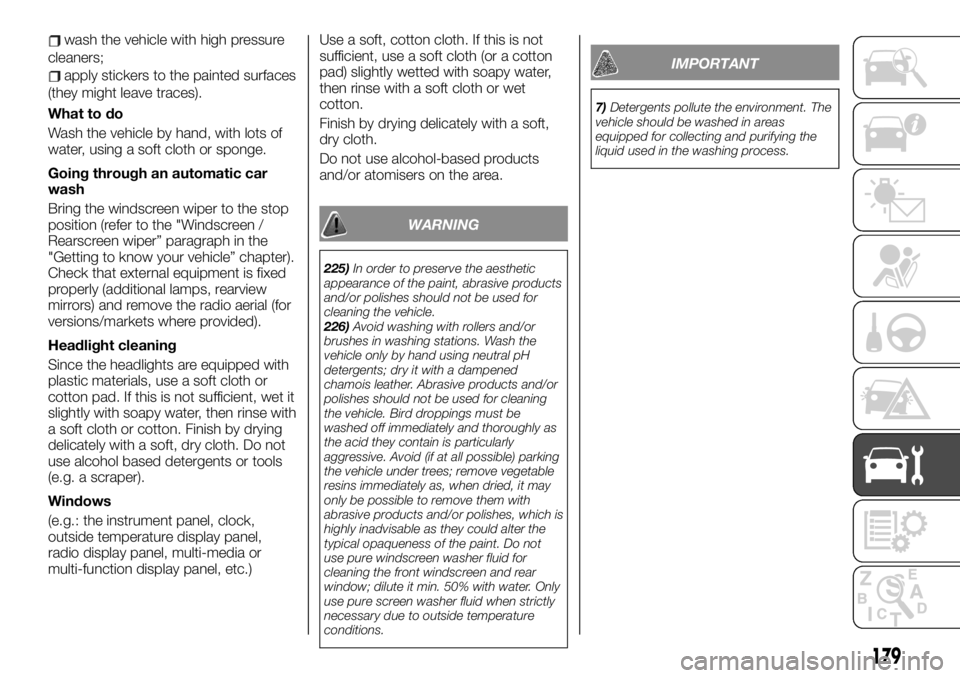
wash the vehicle with high pressure
cleaners;
apply stickers to the painted surfaces
(they might leave traces).
What to do
Wash the vehicle by hand, with lots of
water, using a soft cloth or sponge.
Going through an automatic car
wash
Bring the windscreen wiper to the stop
position (refer to the "Windscreen /
Rearscreen wiper” paragraph in the
"Getting to know your vehicle” chapter).
Check that external equipment is fixed
properly (additional lamps, rearview
mirrors) and remove the radio aerial (for
versions/markets where provided).
Headlight cleaning
Since the headlights are equipped with
plastic materials, use a soft cloth or
cotton pad. If this is not sufficient, wet it
slightly with soapy water, then rinse with
a soft cloth or cotton. Finish by drying
delicately with a soft, dry cloth. Do not
use alcohol based detergents or tools
(e.g. a scraper).
Windows
(e.g.: the instrument panel, clock,
outside temperature display panel,
radio display panel, multi-media or
multi-function display panel, etc.)Use a soft, cotton cloth. If this is not
sufficient, use a soft cloth (or a cotton
pad) slightly wetted with soapy water,
then rinse with a soft cloth or wet
cotton.
Finish by drying delicately with a soft,
dry cloth.
Do not use alcohol-based products
and/or atomisers on the area.
WARNING
225)In order to preserve the aesthetic
appearance of the paint, abrasive products
and/or polishes should not be used for
cleaning the vehicle.
226)Avoid washing with rollers and/or
brushes in washing stations. Wash the
vehicle only by hand using neutral pH
detergents; dry it with a dampened
chamois leather. Abrasive products and/or
polishes should not be used for cleaning
the vehicle. Bird droppings must be
washed off immediately and thoroughly as
the acid they contain is particularly
aggressive. Avoid (if at all possible) parking
the vehicle under trees; remove vegetable
resins immediately as, when dried, it may
only be possible to remove them with
abrasive products and/or polishes, which is
highly inadvisable as they could alter the
typical opaqueness of the paint. Do not
use pure windscreen washer fluid for
cleaning the front windscreen and rear
window; dilute it min. 50% with water. Only
use pure screen washer fluid when strictly
necessary due to outside temperature
conditions.
IMPORTANT
7)Detergents pollute the environment. The
vehicle should be washed in areas
equipped for collecting and purifying the
liquid used in the washing process.
179
Page 182 of 236
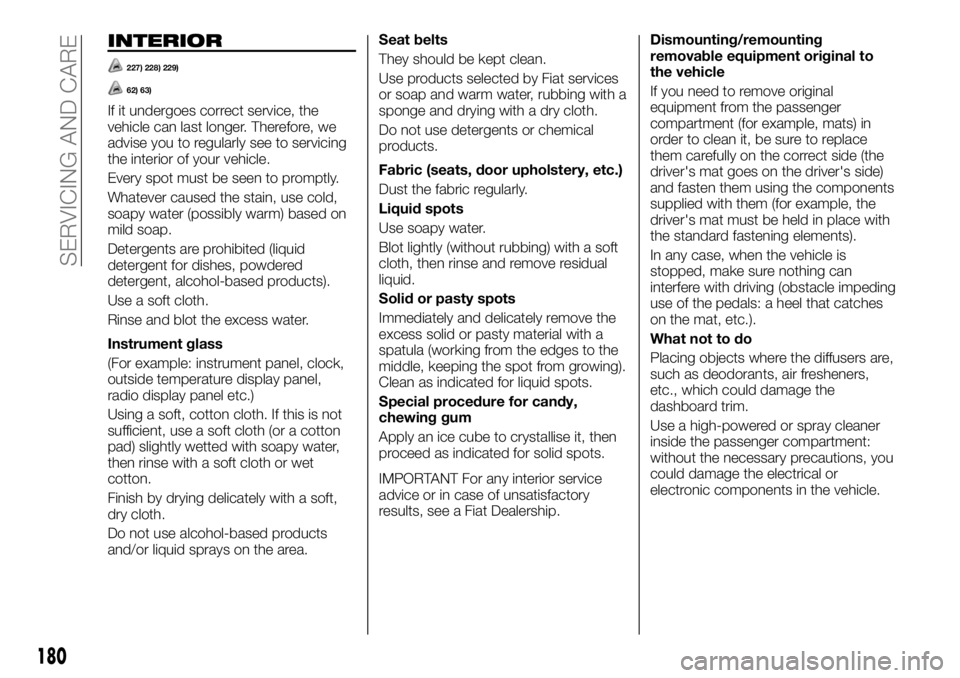
INTERIOR
227) 228) 229)
62) 63)
If it undergoes correct service, the
vehicle can last longer. Therefore, we
advise you to regularly see to servicing
the interior of your vehicle.
Every spot must be seen to promptly.
Whatever caused the stain, use cold,
soapy water (possibly warm) based on
mild soap.
Detergents are prohibited (liquid
detergent for dishes, powdered
detergent, alcohol-based products).
Use a soft cloth.
Rinse and blot the excess water.
Instrument glass
(For example: instrument panel, clock,
outside temperature display panel,
radio display panel etc.)
Using a soft, cotton cloth. If this is not
sufficient, use a soft cloth (or a cotton
pad) slightly wetted with soapy water,
then rinse with a soft cloth or wet
cotton.
Finish by drying delicately with a soft,
dry cloth.
Do not use alcohol-based products
and/or liquid sprays on the area.Seat belts
They should be kept clean.
Use products selected by Fiat services
or soap and warm water, rubbing with a
sponge and drying with a dry cloth.
Do not use detergents or chemical
products.
Fabric (seats, door upholstery, etc.)
Dust the fabric regularly.
Liquid spots
Use soapy water.
Blot lightly (without rubbing) with a soft
cloth, then rinse and remove residual
liquid.
Solid or pasty spots
Immediately and delicately remove the
excess solid or pasty material with a
spatula (working from the edges to the
middle, keeping the spot from growing).
Clean as indicated for liquid spots.
Special procedure for candy,
chewing gum
Apply an ice cube to crystallise it, then
proceed as indicated for solid spots.
IMPORTANT For any interior service
advice or in case of unsatisfactory
results, see a Fiat Dealership.Dismounting/remounting
removable equipment original to
the vehicle
If you need to remove original
equipment from the passenger
compartment (for example, mats) in
order to clean it, be sure to replace
them carefully on the correct side (the
driver's mat goes on the driver's side)
and fasten them using the components
supplied with them (for example, the
driver's mat must be held in place with
the standard fastening elements).
In any case, when the vehicle is
stopped, make sure nothing can
interfere with driving (obstacle impeding
use of the pedals: a heel that catches
on the mat, etc.).
What not to do
Placing objects where the diffusers are,
such as deodorants, air fresheners,
etc., which could damage the
dashboard trim.
Use a high-powered or spray cleaner
inside the passenger compartment:
without the necessary precautions, you
could damage the electrical or
electronic components in the vehicle.
180
SERVICING AND CARE
Page 183 of 236
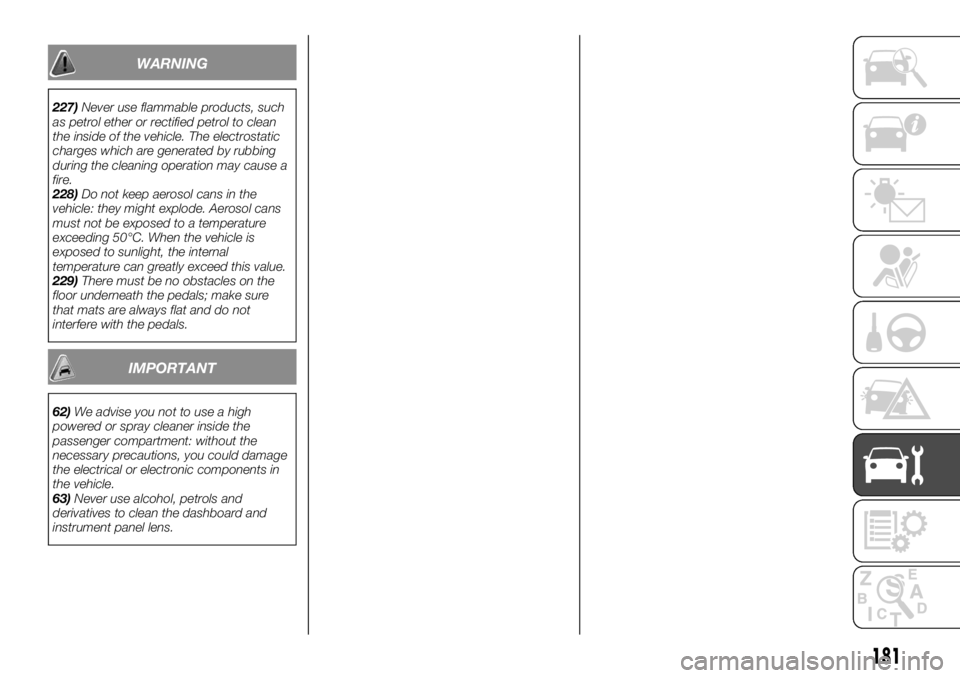
WARNING
227)Never use flammable products, such
as petrol ether or rectified petrol to clean
the inside of the vehicle. The electrostatic
charges which are generated by rubbing
during the cleaning operation may cause a
fire.
228)Do not keep aerosol cans in the
vehicle: they might explode. Aerosol cans
must not be exposed to a temperature
exceeding 50°C. When the vehicle is
exposed to sunlight, the internal
temperature can greatly exceed this value.
229)There must be no obstacles on the
floor underneath the pedals; make sure
that mats are always flat and do not
interfere with the pedals.
IMPORTANT
62)We advise you not to use a high
powered or spray cleaner inside the
passenger compartment: without the
necessary precautions, you could damage
the electrical or electronic components in
the vehicle.
63)Never use alcohol, petrols and
derivatives to clean the dashboard and
instrument panel lens.
181
Page 184 of 236
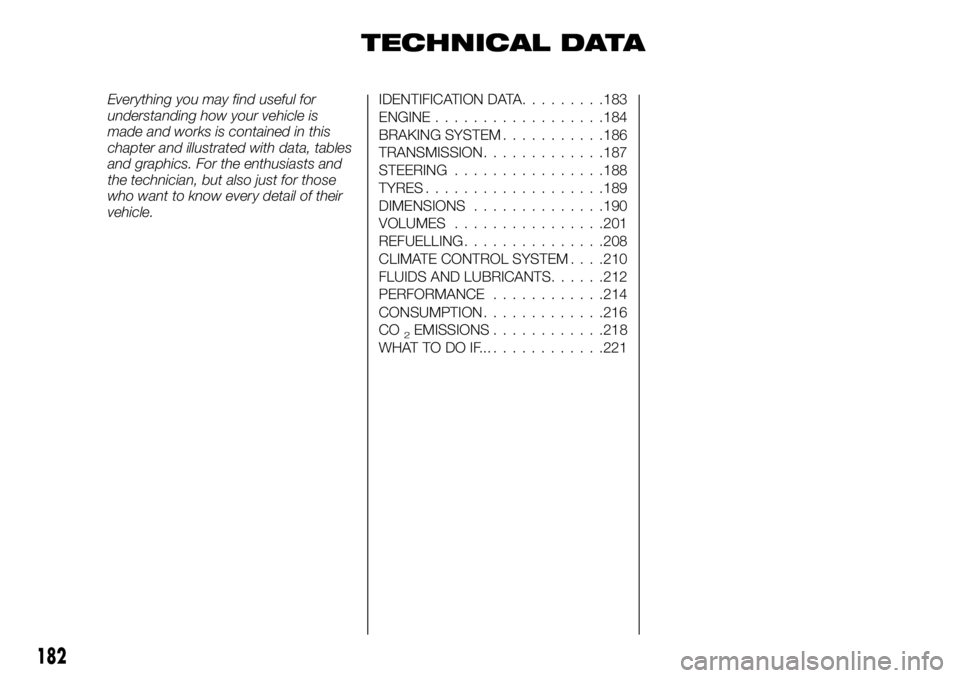
TECHNICAL DATA
Everything you may find useful for
understanding how your vehicle is
made and works is contained in this
chapter and illustrated with data, tables
and graphics. For the enthusiasts and
the technician, but also just for those
who want to know every detail of their
vehicle.IDENTIFICATION DATA.........183
ENGINE..................184
BRAKING SYSTEM...........186
TRANSMISSION.............187
STEERING................188
TYRES...................189
DIMENSIONS..............190
VOLUMES................201
REFUELLING...............208
CLIMATE CONTROL SYSTEM. . . .210
FLUIDS AND LUBRICANTS......212
PERFORMANCE............214
182
CONSUMPTION.............216
CO
2EMISSIONS............218
WHATTODOIF...............221
Page 185 of 236
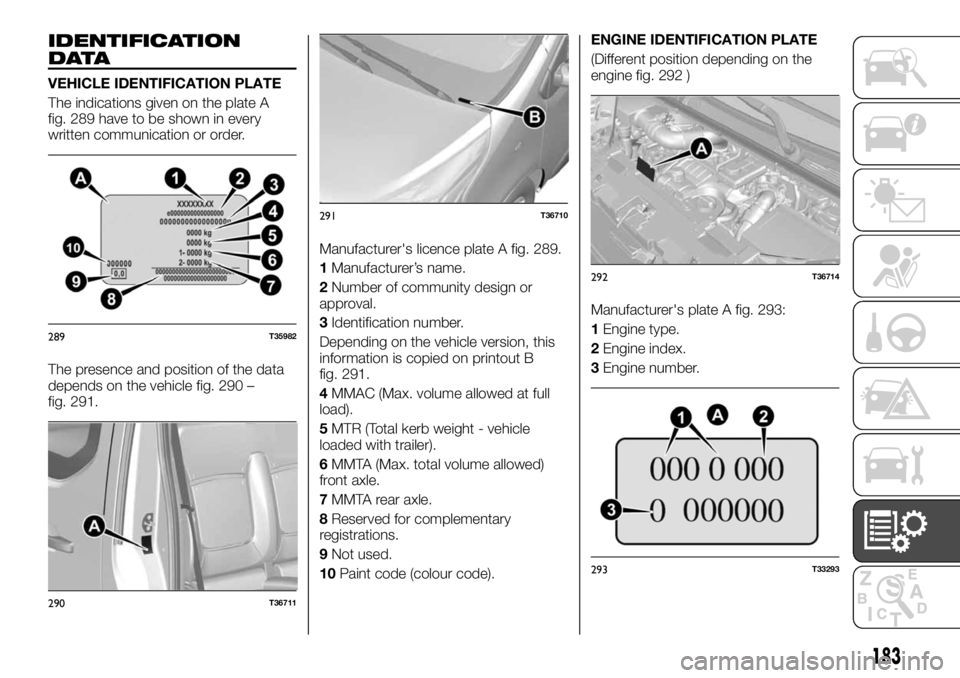
IDENTIFICATION
DATA
VEHICLE IDENTIFICATION PLATE
The indications given on the plate A
fig. 289 have to be shown in every
written communication or order.
The presence and position of the data
depends on the vehicle fig. 290 –
fig. 291.Manufacturer's licence plate A fig. 289.
1Manufacturer’s name.
2Number of community design or
approval.
3Identification number.
Depending on the vehicle version, this
information is copied on printout B
fig. 291.
4MMAC (Max. volume allowed at full
load).
5MTR (Total kerb weight - vehicle
loaded with trailer).
6MMTA (Max. total volume allowed)
front axle.
7MMTA rear axle.
8Reserved for complementary
registrations.
9Not used.
10Paint code (colour code).ENGINE IDENTIFICATION PLATE
(Different position depending on the
engine fig. 292 )
Manufacturer's plate A fig. 293:
1Engine type.
2Engine index.
3Engine number.
289T35982
290T36711
291T36710
292T36714
293T33293
183
Page 186 of 236
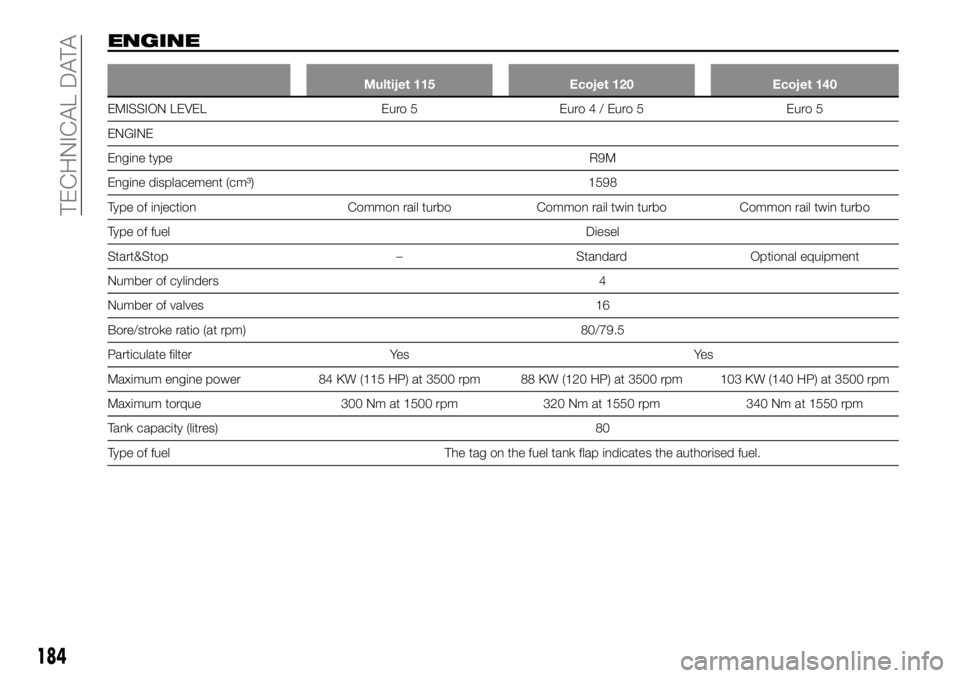
ENGINE
Multijet 115 Ecojet 120 Ecojet 140
EMISSION LEVEL Euro 5 Euro4/Eur
o5 Euro5
ENGINE
Engine typeR9M
Engine displacement (cm³) 1598
Type of injection Common rail turbo Common rail twin turbo Common rail twin turbo
Type of fuelDiesel
Start&Stop – Standard Optional equipment
Number of cylinders 4
Number of valves 16
Bore/stroke ratio (at rpm) 80/79.5
Particulate filter Yes Yes
Maximum engine power 84 KW (115 HP) at 3500 rpm 88 KW (120 HP) at 3500 rpm 103 KW (140 HP) at 3500 rpm
Maximum torque 300 Nm at 1500 rpm 320 Nm at 1550 rpm 340 Nm at 1550 rpm
Tank capacity (litres) 80
Type of fuel The tag on the fuel tank flap indicates the authorised fuel.
184
TECHNICAL DATA
Page 187 of 236
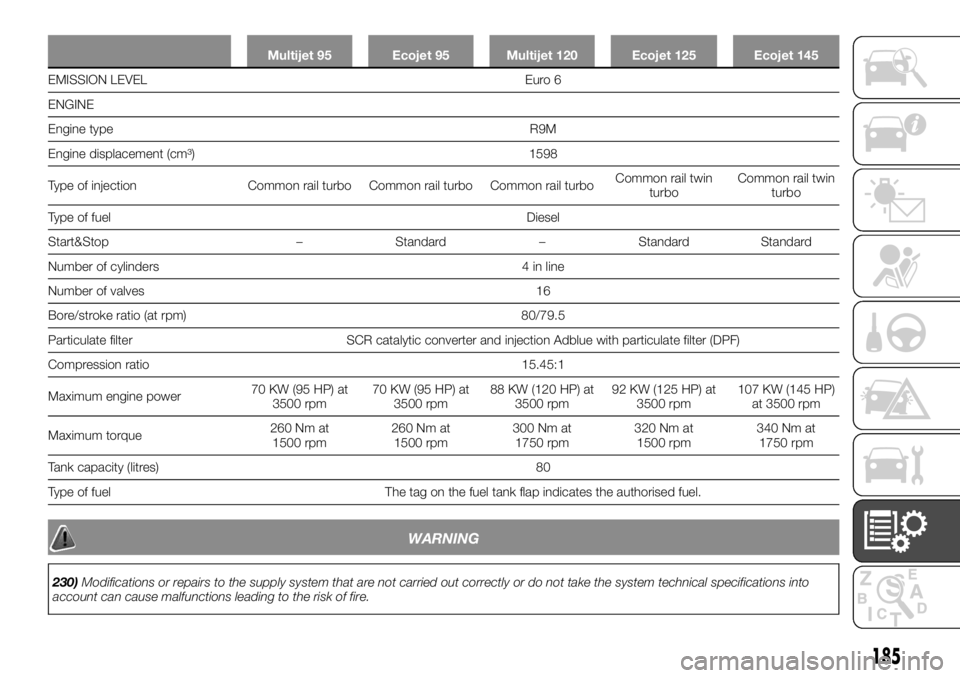
Multijet 95 Ecojet 95 Multijet 120 Ecojet 125 Ecojet 145
EMISSION LEVEL Euro 6
ENGINE
Engine
typeR9M
Engine displacement
(cm³) 1598
Type of injection Common rail turbo Common rail turbo Common rail turboCommon rail twin
turboCommon rail twin
turbo
Type of fuelDiesel
Start&Stop – Standard – Standard Standard
Number of cylinders 4 in line
Number of valves 16
Bore/stroke ratio (at rpm) 80/79.5
Particulate filter SCR catalytic converter and injection Adblue with particulate filter (DPF)
Compression ratio 15.45:1
Maximum engine power70 KW (95 HP) at
3500 rpm70 KW (95 HP) at
3500 rpm88 KW (120 HP) at
3500 rpm92 KW (125 HP) at
3500 rpm107 KW (145 HP)
at 3500 rpm
Maximum torque260 Nm at
1500 rpm260 Nm at
1500 rpm300 Nm at
1750 rpm320 Nm at
1500 rpm340 Nm at
1750 rpm
Tank capacity (litres) 80
Type of fuel The tag on the fuel tank flap indicates the authorised fuel.
WARNING
230)Modifications or repairs to the supply system that are not carried out correctly or do not take the system technical specifications into
account can cause malfunctions leading to the risk of fire.
185
Page 188 of 236
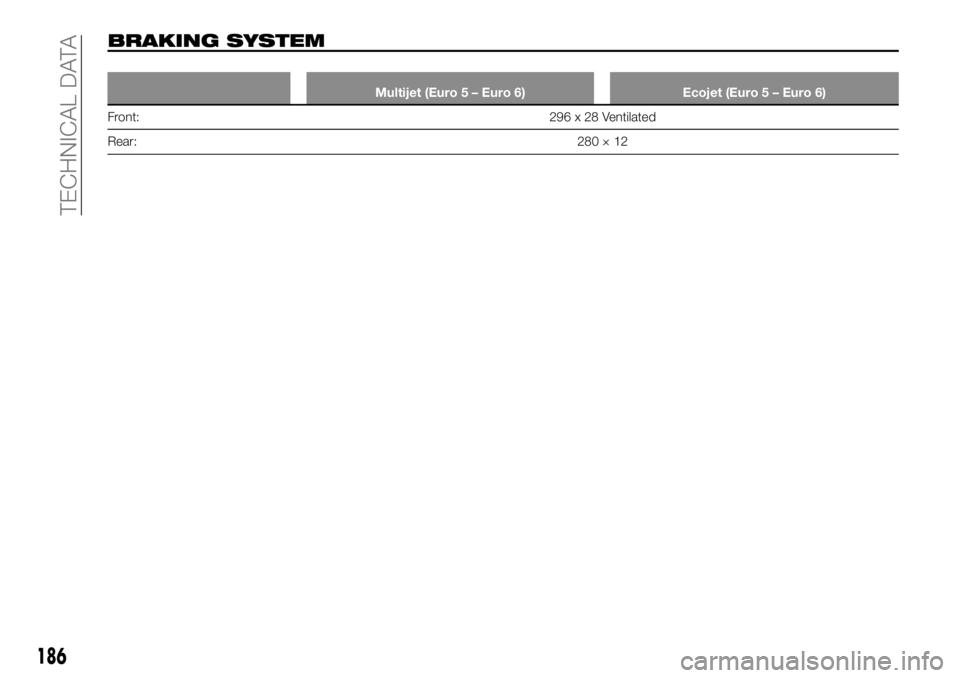
BRAKING SYSTEM
Multijet (Euro 5 – Euro 6) Ecojet (Euro 5 – Euro 6)
Front: 296 x 28 Ventilated
Rear:280×1
2
186
TECHNICAL DATA
Page 189 of 236
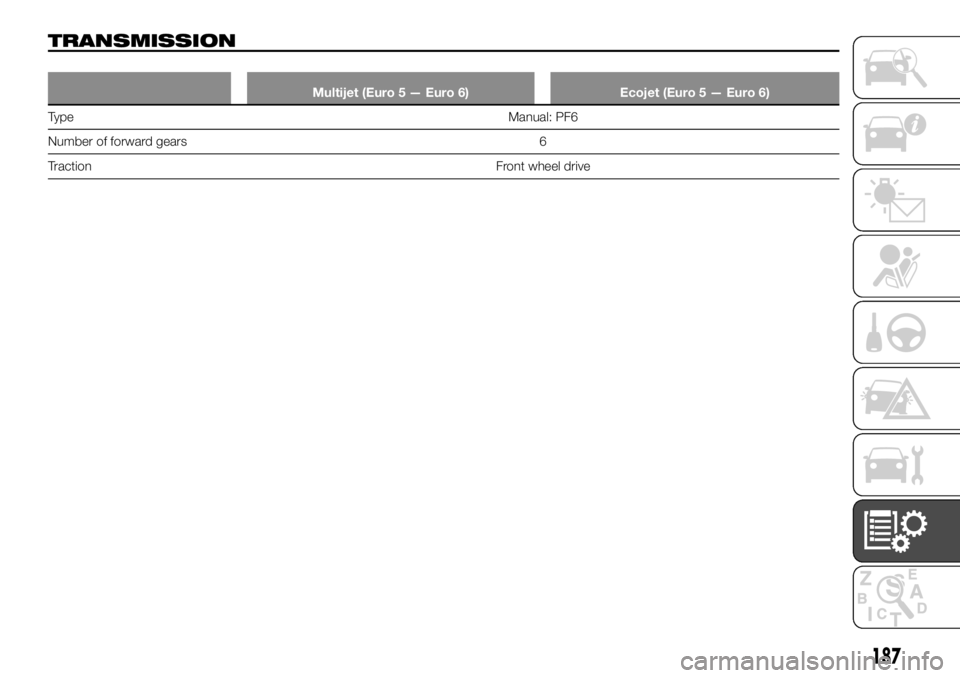
TRANSMISSION
Multijet (Euro 5 — Euro 6) Ecojet (Euro 5 — Euro 6)
TypeManual: PF6
Number of
forward gears 6
Traction Front wheel drive
187
Page 190 of 236
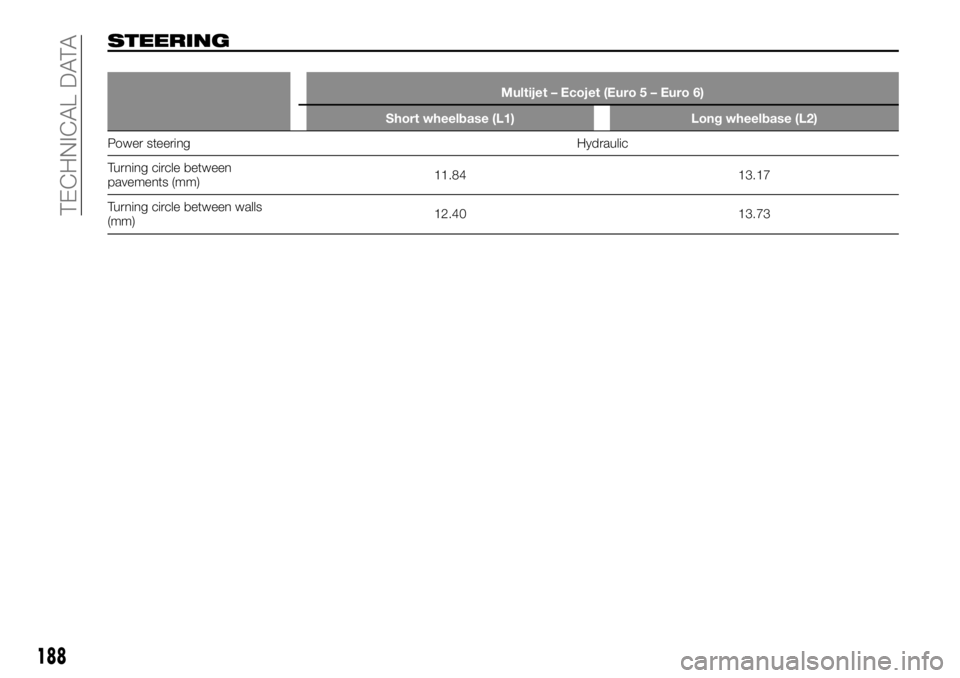
STEERING
Multijet – Ecojet (Euro 5 – Euro 6)
Short wheelbase (L1) Long wheelbase (L2)
Power steering Hydraulic
Turning
circle between
pavements (mm)11.84 13.17
Turning circle between walls
(mm)12.40 13.73
188
TECHNICAL DATA